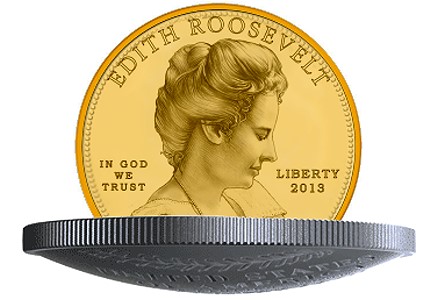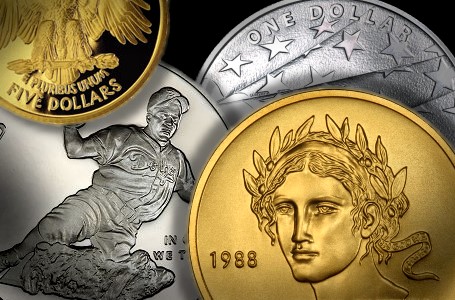By Louis Golino for CoinWeek ………
I recently met a new coin collector and spent a little time giving him some advice about how to get the most out of his new hobby. He and wife had decided to put some money into silver bullion and some modern coins like American silver eagles and silver Lunar horse issues. He already knew about professional coin grading and certified coin data and decided to join a grading service so he could submit coins for grading.
It soon became clear to me that the importance of owning graded coins, especially those that receive 70 grades, was a major consideration for this new numismatist. There is of course nothing wrong with that, and such views have helped to increase the role of grading in modern coin collecting by leaps and bounds in recent years. But it seemed to me that someone this new to the hobby should be focusing more on the coins themselves and not as much on grading.
 Grading of modern coins has certainly been a huge revenue maker for the coin grading services. But we are now at the point where some collectors seem obsessed with having their coins in specific types of matched labels, and others compete feverishly for registry sets of the highest-graded modern coins. I think it’s time to step back and ask how all this emphasis on grading of modern coins is affecting the fastest-growing segment of numismatics, which is modern coins.
Grading of modern coins has certainly been a huge revenue maker for the coin grading services. But we are now at the point where some collectors seem obsessed with having their coins in specific types of matched labels, and others compete feverishly for registry sets of the highest-graded modern coins. I think it’s time to step back and ask how all this emphasis on grading of modern coins is affecting the fastest-growing segment of numismatics, which is modern coins.
As I have argued before, if you purchase high-quality modern coins and think they have a decent chance of getting the top grade, it is often worth submitting them as the payoff can be substantial. It helps to know an experienced dealer, who may be able to offer their opinion on whether the coins are worth sending in for grading.
At the same time, it is easy to get burned doing that, as anyone who has tried it has discovered. For dealers it is very cost effective, as they submit enough volume that inevitably a certain percentage of their coins come back with top grades, and they also pay bulk rates, as do other high-volume submitters.
Plus, the market for 70-graded coins is particularly volatile, and as shifts in the supply of coins in that grade ebb and flow, and as more coins are submitted over time and more top grade coins are added to certified coin populations, values keep changing. This can frequently mean lower and lower prices for 70-graded coins over time.
Because of these factors it is easy to end up overpaying for top-graded modern coins. A particular coin may have a high perceived rarity at a certain moment in time, only to tumble in value when the coin turns out not to be so rare down the road.
 A good example of this phenomenon is current prices for PCGS MS69 DMPL examples of the 2013 Fort McHenry 5 ounce America the Beautiful bullion coin. It is true that at the moment this coin has the lowest population of PCGS graded 2013 ATB coins, but that is likely to change as more coins are graded. The quality of these coins has improved in the last couple years, which further increases the likelihood of more high grade examples surfacing later. In recent weeks buyers on e-Bay have paid as much as $1800 for this coin, yet ungraded examples cost $130 or less, and SP70 examples of the recently sold-out numismatic version are only going for about $200 on e-Bay. To me it is risky to put that much into a coin that will probably not hold its value. Moreover, I consider this to be emblematic of the downside of grading modern coins, which can create an artificial rarity out of a common coin, in this case what I would call a temporary condition rarity.
A good example of this phenomenon is current prices for PCGS MS69 DMPL examples of the 2013 Fort McHenry 5 ounce America the Beautiful bullion coin. It is true that at the moment this coin has the lowest population of PCGS graded 2013 ATB coins, but that is likely to change as more coins are graded. The quality of these coins has improved in the last couple years, which further increases the likelihood of more high grade examples surfacing later. In recent weeks buyers on e-Bay have paid as much as $1800 for this coin, yet ungraded examples cost $130 or less, and SP70 examples of the recently sold-out numismatic version are only going for about $200 on e-Bay. To me it is risky to put that much into a coin that will probably not hold its value. Moreover, I consider this to be emblematic of the downside of grading modern coins, which can create an artificial rarity out of a common coin, in this case what I would call a temporary condition rarity.
Another factor to keep in mind is that grading standards evolve over time. When the first year’s ATB 5 ounce coins were issued, I had some graded and received MS69 DMPL for a coin that has a rather noticeable scratch on the surface. Coins graded more recently are unlikely to have those kind of imperfections, but when the 2010 coins came out there was nothing to compare them to.
This discussion has been focused so far on American coins, but there is also the growing trend of having modern coins graded. As the modern world coin market continues to expand, so does the market for 70-graded coins.
But unless you are buying a coin raw and submitting it because you feel strongly that it will be graded 70 and because you have studied retail values and seen it is worth the expense, I am not sure it is advisable to grade modern world coins, or buy them graded unless they are a good deal. In fact, like many buyers I tend to prefer owning modern coins in their original packaging, which is frequently a better way to display the coins, especially when it comes in an attractive box.
As a result of the factors and trends discussed above, my own view on the merits of grading modern coins is changing. I am by no means categorically against it, but I have reached the point where I am more selective than I used to be about submitting modern coins for grading as well as purchasing already-graded modern coins.
To be sure, high-grade graded examples of coins with a lackluster performance in raw form, such as the 2012 and 2013 special American silver eagle two-coin sets, are much more desirable than raw sets. This year’s sets seem like a very good buy to me at current retail prices for 70-graded West Point sets, especially given the recent announcement of a lower mintage than originally indicated for these coins. Prices are low on the retail market because there are plenty of graded sets today, but I doubt those sets will remain so cheap forever.
But at the same time, there are coins I had graded that I regretted submitting because they looked like 70’s to me and came back as 69’s. When trying to sell modern U.S. coins, you are better off with a raw coin in OGP than a 69. I would therefore recommend being very judicious about which coins you submit.
The grading of modern coins has without question done a lot to expand the market for such coins and has it merits, but ultimately it is the coins, not the slabs or labels, that should be of prime importance to collectors and buyers.
 Louis Golino is a coin collector and numismatic writer, whose articles on coins have appeared in Coin World, Numismatic News, a number of different coin web sites in addition to being a contributor to “American Hard Assets magazine”. His column for CoinWeek, “The Coin Analyst,” covers U.S. and world coins and precious metals. He collects U.S. and European coins and is a member of the ANA, PCGS, NGC, and CAC. He has also worked for the U.S. Library of Congress and has been a syndicated columnist and news analyst on international affairs for a wide variety of newspapers and web sites.
Louis Golino is a coin collector and numismatic writer, whose articles on coins have appeared in Coin World, Numismatic News, a number of different coin web sites in addition to being a contributor to “American Hard Assets magazine”. His column for CoinWeek, “The Coin Analyst,” covers U.S. and world coins and precious metals. He collects U.S. and European coins and is a member of the ANA, PCGS, NGC, and CAC. He has also worked for the U.S. Library of Congress and has been a syndicated columnist and news analyst on international affairs for a wide variety of newspapers and web sites.





I prefer to have all of my gold and silver world coins graded,not so much for the grade but for storage and preservation purposes. I don’t like presentation cases and holders because, often times, they are odd-sized and unwieldy, presenting a storage problem. Also, I believe coins are better preserved in grading service slabs than in presentation cases and holders.
the 2006w pcgs ms70 silver eagles have gone from over 1000 dollars down to 150 dollars in the last few years
I am pleased to see that of the five coins pictured with his article – that three of them are in my collection. Not that anybody cares but me.
Always enjoy and look forward to your writings. Have never had a coin graded – OGP for me.
Thanks Mr. Golino
Some great advice, I wouldn’t even think about submitting a modern coin for grading,it is cheaper and easier to purchase one that has already been graded. with an already graded coin there are no suprises. The same can be said for some of the inflated prices of certain circulated coins,for example, a modern 2004 uncirculated dime graded ,ms 68 ft, recently sold on e-bay for over $500.00 dollars ! I would rather submit my own coins and take a chance than pay this premium. The same coin in ,ms 67 ft, is being sold in a “buy it now” auction for $69.00. Again you could submit your own coins for a fraction of that cost. With over 1.3 TRILLION coins minted , I don’t think it that hard to find a good example.
Great article!
Thanks to everyone for their kind words and interest in this column, and for sharing your insights and experiences. Numismatic knowledge is a two-way process between writers and readers.
Slabs can be useful for perseveration, but remember none of them are totally inert, and silver coins in particular can still tone in them.
Buying graded moderns can be a good way to go, but it depends on the cost. If a modern world coin is graded 69 and costs substantially more than a raw counterpart, to me it’s not worth it.
This is clearly a topic on which everyone has a strong view. All views are welcome.
For those who have been waiting to see when a bullion 5 oz ATB would be graded MS70 by the top two companies. It has happened. It is a Ft. McHenry coin, and I am sure the owner is very pleased as it would likely be worth thousands esp. being the first one to be graded 70. That is until or unless lots more pop up later!
I just bought & received from the mint 2 gold mercury dimes & really like the packaging they came in & wondering if I should have them graded? (Paid $200.00 each)
I also plan on buying the gold quarter & half dollar coming out sometime this year.
Thank You!!!!
Mike- Graded examples are coming down in price. You may want to wait a bit longer and buy one already graded if you want one of those.